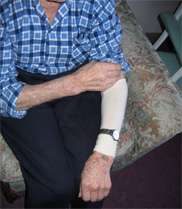'Second skin' helps care for all

CSIRO scientists are creating a ‘second skin’ made from wool and Lycra to help protect the body against wounds and major traumas.
Advances by CSIRO in material sciences are creating ‘second skin’ technology that can protect the body against wounds and major traumas.
By incorporating so-called ‘smart textiles’, second skin technology is an emerging biomedical field with applications in medicine, sport, occupational safety, military and emergency services.
A major use of the technology is expected to be in patient care – in particular the care of the elderly, or bed-ridden. According to recent studies, nearly 15 per cent of people in high-care nursing homes have a ‘skin tear’ at any one time.
CSIRO Textile and Fibre Technology researchers at Geelong have set out to develop a specialised fabric that, in the first instance, will prevent skin tear among frail patients.
The textile chosen by CSIRO is 95 per cent fine merino wool and 5 per cent Lycra, a combination that can be worked into a soft, lightweight textile that is cool in summer, while still preventing the chills that accompany poor circulation.
The fabric is about to undergo clinical trials after favourable patient trials.
Dr Andrew Poole, from CSIRO’s textiles division says skin tears are caused by age-related changes, which reduce blood flow to the skin and cause a flattening of skin layers.
“Because the layers are not anchored together as well, the skin becomes susceptible to shear injuries,” he says.
“Simple knocks or even being helped from a wheelchair can cause the skin to tear.”
A list of 20 features that a second skin product needs to have to satisfy both clinicians and patients was created by the team.
The researchers have developed a specialised knit structure with two crucial mechanical properties. The textile can stretch by 100 per cent without applying any significant extra pressure, which in itself would be problematic. This makes garments easy to put on over ankles and wrists then contracting to provide the necessary form-fitting to protect the skin against the friction that causes tears.
The textile is also chemically treated to provide a machine-washable garment that maintains its integrity.
With the support of Australian Wool Innovation (AWI) and international manufacturer of wound management products, Smith & Nephew, the CSIRO has recently undertaken a wearer trial.
In the trial, nursing home residents wore the garments for extended periods. The material left no marking on the skin and because of the high wool content, the material didn’t accumulate moisture which can cause fabric to smell. The trial ‘second skin’ garments were worn for five consecutive days before laundering.
With the success of the wearer trial, the research team has just got the go-ahead for a six-month clinical trial with about 400 participants.
The CSIRO team, led by Robin Cranston, are now planning to extend their research into ‘smart textiles’ – materials able to alter their characteristics in response to external stimuli.
“In advanced wound management field we can conceive textiles that will be able to sense and respond to biological or physical changes like temperature, pH, wound inflammation or vital life signs like cardio rhythm,” says Mr Cranston.
“In other areas, there are phase-changing polymers that can change their form and allow a textile to go from being a flat, cool fabric to a high bulk, insulating material as the temperature drops.”
Mr Cranston says CSIRO is developing textiles able to carry these types of technologies.
He says the challenge is to create the appropriate textile for a particular purpose, such as wound dressing, and then give it the capacity to incorporate these other, related, technologies.
“One of the most exciting areas of potential involves incorporating electronic sensors linked to telemetry devices that are capable of functions such as monitoring cardiovascular function. We already have a lot of ideas about the kind of textiles that are needed,” he says.
Source: CSIRO





















